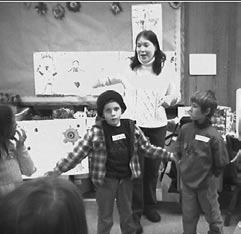
3 minute read
MusicontheMove!Dr.FrednaGrimland,Ph.D.
Because the OMEA Conference is always a time for meeting and greeting, networking, and sharing, consider the possibility of a kind of collegial exchange with a slightly different outcome—Music on the Move.
What is Music on the Move? The Southern Oregon University (SOU) MENC collegiate members (CMENC) decided that they wanted to share their love of music and their pleasure for music making by visiting local elementary schools. Some of these schools do not have music specialists teaching music curriculum; others have classroom teachers who are willing to extend experiences in general music lessons and activities. University students planned small group lessons to present to children in such elementary classes.
Advertisement
Various musical activities were organized and presented by SOU students, who planned 10-minute mini-modules with singing and musically related experiences. Some of the groups presented songs and allowed the children to suggest text substitutions. Others taught songs and included dance or movement. One group used traditional children’s literature to guide the children to interpret the story with dramatic movements and with instruments. The children were divided into small groups of approximately 8 members. Each small group circulated to a different activity center. At the end of the 30- to 45minute presentation, the children had participated in three different musical experiences led by music education students.
The interaction between elementary students and college students has a very special dynamic. In a sense, the university presenters are the “big kids.” Their authority is not questioned because they are there to provide a fun diversion from the activities of the typical school day. The children welcome them and don’t realize that they are learning. College students experience many realities of teaching:

1) Successful lessons take planning.
2) Teaching takes energy!
3) Learners are varied in their levels of experiences and abilities; accommodations have to be made—sometimes extemporaneously.
4) Each child is unique, and each group is fresh and different.
5) The comfort level for instruction increases with repeated experiences.
The benefits for community and pre-service music educators are immense. Children in these schools receive more music, even though the refinement of the instructional skills of the leaders is in the learning/novice stage, which should by no means be considered as a substitution for sequential instruction by qualified, certified music specialists. For university students, these events are not graded; they are safe occasions to experiment with the strategies of teaching they are learning and to make theoretical pedagogical knowledge an acquired skill. In addition, the feeling of satisfaction university students gain from participating in these types of activities encourages them to continue to pursue teaching as a profession; they feel gratification from the opportunity to give of themselves.
As music-teacher educators, we must create as many opportunities for our students to experience the act of teaching as possible. Applied music-education instructors create venues for performances ranging from studio classes to departmental recitals, concerts, contests, and, ultimately, paid performances. These opportunities to experiment with their playing or singing techniques are invaluable for learning proficiency in the role of performer. Similarly, music-education students need the opportunities to “perform.” Our instrument is the classroom. Identification with a professional role comes with experiences in the role (Simpson, 1967; L’Roy, 1983; Paul, 1996). Perception of one’s self as a music educator helps direct decision-making during teaching and also conditions responses in the leadership role of teacher (Conkling & Henry, 2002). Experiences in music education classes that extend beyond the music methods class, where peers provide unreal - istic responses, and into field experiences, beyond observation, help prepare confident and competent music educators—even novice ones.
Conference time is a great occasion for university music-teacher educators to meet one another, make contact with the K-University music educators in, around, and beyond their own communities, and probe ways that university students can help the schools. The schools in turn can help music education students by providing opportunities to teach. Let’s make Music on the Move a statewide campaign.
References
Conkling, S. &Henry, W. (2002, Spring). The impact of professional development partnerships: Our part of the story. Online Journal of Music Teacher Education [On-line available to MENC members].
L’Roy, D. (1983) The development of occupational identity in undergraduate music education majors. Unpublished doctoral dissertation, North Texas State University, Denton, TX.
Paul, S. (1996, May). The effects of peer teaching experiences on the professional teacher role development of undergraduate instrumental music education majors. Paper presented at the Qualitative Methodologies in Music Education Research Conference II, School of Music, the University of Illinois, Urbana-Champaign.
Simpson, I. (1967). Patterns of socialization into professions: The case of student nurses. Sociological Inquiry, 37, 47-59.








